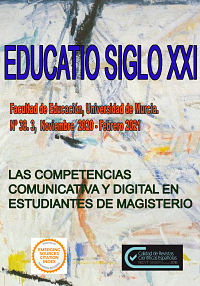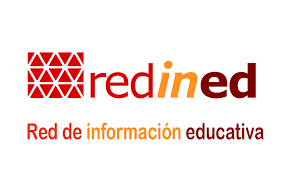Bilingual programs in Primary Education: What do teachers say?
Abstract
INTRODUCTION. This article explores the satisfaction of teachers in the Region of Murcia involved in bilingual education and presents the proposals they make to improve its implementation. METHOD. With a descriptive research methodology, 78 teachers of public and private primary schools distributed among all areas of the Region of Murcia and with several years of experience in bilingual education were interviewed. RESULTS AND DISCUSSION. The main results show that the satisfaction of teachers is high, despite widespread complaints about the lack of involvement of the education authorities and doubts about the advantages of these programs for students with educational needs.
Downloads
-
Abstract991
-
PDF (Español (España))694
References
De Matos, M.E.E. (2014). CLIL as a Catalyst for Developing Reflective Practice in Foreign Language Teacher Education (Tesis Doctoral).Universidad de Porto, Portugal.
Dobson, A., Pérez, M.D. y Johnstone, R. (2011). Programa de Educación Bilingüe en España. Informe de evaluación. Resultados de la investigación independiente sobre el Programa de Educación Bilingüe del Ministerio de Educación y el British Council en España. Ministerio de Educación y British Council.
Ferre, F.M., Jódar, F.J. y Martín, J. (2014). El programa bilingüe de alemán en la Enseñanza Secundaria: un ejemplo de coordinación y cooperación didáctica. Magazin/Extra, 1, 26-32. Recuperado de: http://www.fage.es/magazin_extra/magazin_e_1/26a32.pdf
Fernández, R. &Halbach, A. (2011).Analysing the Situation of Teachers in the Madrid Bilingual Project after Four Years of Implementation. In Y. Ruiz de Zarobe, J. M. Sierra y F. Gallardo del Puerto (Eds.), Content and Foreign Language Integrated Learning. Contributions to Multilingualism in European Contexts (pp. 241–270). Frankfurt am Main, Alemania: Peter Lang
García, E. (2014). Diseño, desarrollo y evaluación de los programas de enseñanza bilingüe en el entorno escolar de Soria (Tesis doctoral). Universidad de Valladolid, España.
Halbach, A. (2008). Una metodología para la enseñanza bilingüe en la etapa de Primaria. Revista de Educación, 346, 455–466.
Hunt, M., Neofitou, A. & Redford, J. (2009). Developing CLIL training for modern languages teacher trainees. In D. Marsh, P. Mehisto, D. Wolff, R. Aliaga, T. Asikainen, M.J. Frigols-Martin, S. Hughes & G. Langé (Eds.), CLIL Practice: Perspectives from the Field (pp. 110-116). Jyväskylä, Finlandia: University of Jyväskylä.
Infante, D., Benvenuto, G. &Lastrucci, E. (2009).The Effects of CLIL from the Perspective of Experienced Teachers.In D. Marsh, P. Mehisto, D. Wolff, R. Aliaga, T. Asikainen, M.J. Frigols-Martin, S. Hughes & G. Langé (Eds.), CLIL Practice: Perspectives from the Field (pp. 156-163). Jyväskylä, Finlandia: University of Jyväskylä.
Kvale, S. (2011). Las entrevistas en investigación cualitativa. Madrid: Morata.
Lorenzo, F., Casal, S., Moore, P. y Alfonso, Y.M. (2009). Bilingüismo y Educación: Situación de la Red de Centros Bilingües en Andalucía. Sevilla, España: Fundación Centro de Estudios Andaluces.
Méndez, M.C. & Pavón, V. (2012). Investigating the coexistence of the mother tongue and the foreign language through teacher collaboration in CLIL contexts: perceptions and practice of the teachers involved in the plurilingual programme in Andalusia. International Journal of Bilingual Education and Bilingualism, 15(5), 573-592.
Nussbaum, L. (1999). Perspectives actuals per al’ensenyamentil’aprenentatge de llengües estrangeres a l’educatió obligatòria. Perspectiva Escolar, 232, 2-8.
Pavón, V. & Rubio, F.D. (2010).Teacher´ s Concerns and Uncertainties about the Introduction of CLIL Programmes.Porta Linguarum: Revista Internacional de Didáctica de las lenguas extranjeras, 14, 45-58.
Pladevall-Ballester, E. (2015). Exploring primary school CLIL perceptions in Catalonia: students', teachers' and parents' opinions and expectations.International Journal of Bilingual Education and Bilingualism, 18(1), 45-59.
Roldán, H. (2011). Promoción del bilingüismo mediante la inclusión del inglés en un modelo pedagógico enfocado hacia el aprendizaje autónomo. Voces y Silencios: Revista Latinoamericana de Educación, 2(2), 111-127.
Salkind, N. J. (2009). Exploring research (7th ed.). Upper Saddle River, NJ: Pearson
Sasajima, S. (2013).How CLIL Can Impact on EFL Teachers’ Mindsets about Teaching and Learning: An Exploratory Study on Teacher Cognition. International CLIL Research Journal, 2(1), 55-66.
Siguán, M. y Mackey, W.F. (1986).Educación y Bilingüismo. Madrid: Santillana.
Tójar, J.C. (2006). Investigación cualitativa: comprender y actuar. Madrid: La Muralla.

This work is licensed under a Creative Commons Attribution-NonCommercial-NoDerivatives 4.0 International License.
Original work publishes in this journal is subject to the following terms:
1. Murcia University Press (the publishing house) holds the copyright of the publishes work, and favours and allows their reutilization under the use license stated in point 2.
© Servicio de Publicaciones, Universidad de Murcia, 2015
2. Work is published in the electronic edition under a license (Creative Commons Reconocimiento-NoComercial-SinObraDerivada 4.0 España (legal text). They can be copied, used, disseminated, transmitted and publicly presented, as long as: i) authorship and original publication source is acknowledged (journal, publishing house and URL of the work); ii) are not used for commercial purposes; iii) the existence and specifications of this use license is stated.
3. Conditions for self-archive. Authors are allowed and encouraged to disseminate electronically the pre-pint (before review) and/or post-print (accepted for publication) versions of their work before their publication since that favours earlier circulation and dissemination resulting in an increased chance for the authors to be cited and for the work to reach a bigger share of the academic community. Colour: RoMEO: green.







